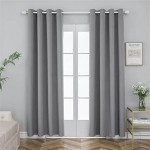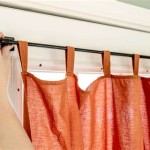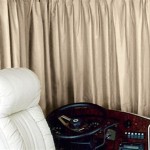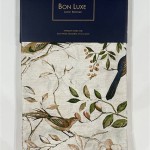Hanging A Shower Curtain Rod: A Comprehensive Guide
Installing a shower curtain rod is a common home improvement task that, while seemingly simple, requires careful consideration and execution to ensure functionality and longevity. A properly installed shower curtain rod is crucial for maintaining a clean and dry bathroom environment by effectively containing water spray during showers. This article provides a detailed guide on how to hang a shower curtain rod, covering various types of rods, necessary tools, installation steps, and potential troubleshooting solutions.
Understanding Different Types of Shower Curtain Rods
Selecting the appropriate shower curtain rod is the first crucial step. Shower curtain rods vary in design, material, and installation method. Choosing the right type depends on individual preferences, bathroom layout, and desired aesthetic.
Tension Rods: These are perhaps the most common and simplest type of shower curtain rod. Tension rods utilize internal springs to create pressure against the bathroom walls, holding the rod in place. They are ideal for renters or those seeking a non-permanent solution, as they require no drilling or hardware. However, tension rods are best suited for lighter shower curtains and may not be as stable as other options, particularly with heavier curtains or frequent pulling.
Fixed Mount Rods: Fixed mount rods are permanently attached to the bathroom walls using screws and wall anchors. They offer superior stability compared to tension rods and are capable of supporting heavier curtains. Installation requires drilling holes and using appropriate anchors, making them a more permanent solution. They are suitable for homeowners who want a durable and reliable shower curtain rod.
Curved Rods: Curved shower curtain rods bow outward, providing additional elbow room within the shower or bathtub enclosure. This design can significantly enhance the showering experience by creating a more spacious feel. Curved rods typically require fixed mount installation, although some tension-based curved rods are available. They are a good option for smaller bathrooms where maximizing shower space is desirable.
Double Rods: Double rods feature two parallel bars, allowing for the use of both a shower curtain liner and a decorative shower curtain. This setup provides enhanced functionality and aesthetic flexibility. Double rods are typically fixed mount and require careful installation to ensure both rods are securely attached.
Specialty Rods: This category encompasses various unique designs, such as corner rods for corner showers or L-shaped rods for specific bathroom layouts. These rods are often custom-designed or require specialized installation techniques. Consultation with a professional might be necessary for complex installations.
Essential Tools and Materials
Before commencing the installation process, gathering the necessary tools and materials is paramount. Having everything readily available will streamline the process and minimize potential delays.
Shower Curtain Rod: The selected shower curtain rod, including all associated hardware (brackets, screws, anchors). Verify that all components are present and undamaged.
Measuring Tape: A measuring tape is essential for accurately determining the desired rod height and position. Precise measurements are crucial for ensuring the curtain hangs properly and covers the shower area effectively.
Level: A level is necessary to ensure the shower curtain rod is installed horizontally. A tilted rod can lead to uneven curtain hanging and an aesthetically unappealing result.
Pencil: A pencil is used to mark the desired location of the rod and mounting brackets on the wall. Light and erasable marks are preferable to avoid permanent damage to the wall surface.
Drill (for Fixed Mount Rods): A power drill with appropriate drill bits is required for creating pilot holes for screws and anchors when installing fixed mount rods. Selecting the correct drill bit size for the anchors is crucial for a secure installation.
Screwdriver (for Fixed Mount Rods): A screwdriver, either manual or powered, is needed to drive screws into the wall anchors, securing the mounting brackets. Ensure the screwdriver head matches the screw type to prevent stripping the screw head.
Wall Anchors (for Fixed Mount Rods): Wall anchors provide added support for screws, especially when drilling into drywall. Select anchors appropriate for the wall material and the weight of the shower curtain.
Stud Finder (Recommended for Fixed Mount Rods): A stud finder helps locate wall studs, providing a more secure attachment point for mounting brackets. Screwing directly into a stud eliminates the need for wall anchors.
Safety Glasses: Safety glasses are essential to protect the eyes from debris during drilling.
Step-by-Step Installation Guide
The installation process varies slightly depending on the type of shower curtain rod being installed. The following provides detailed instructions for both tension rods and fixed mount rods.
Tension Rod Installation:
1. Measure the Opening: Accurately measure the distance between the two walls where the shower curtain rod will be installed. This measurement is crucial for selecting the appropriate tension rod length.
2. Adjust the Rod Length: Extend the tension rod slightly beyond the measured distance. Typically, the rod will have an adjustable inner section that can be twisted to extend or retract its length.
3. Position the Rod: Carefully position the rod at the desired height, ensuring it is level. The height should be sufficient to allow the shower curtain to hang properly and prevent water from escaping the shower area.
4. Secure the Rod: Twist the rod until it creates sufficient tension against the walls to hold it in place. Ensure the rod is firmly seated against the walls and does not slip. Periodically check the rod's stability and readjust if necessary.
Fixed Mount Rod Installation:
1. Determine the Desired Height: Measure and mark the desired height for the shower curtain rod on both walls. Use a level to ensure the marks are aligned horizontally.
2. Locate Wall Studs (Optional): Use a stud finder to locate wall studs behind the drywall. If possible, position the mounting brackets directly over studs for a more secure attachment. If studs are not accessible, proceed with using wall anchors.
3. Mark Bracket Locations: Position the mounting brackets against the wall at the marked height, ensuring they are level. Use a pencil to mark the location of the screw holes on the wall.
4. Drill Pilot Holes: Using a drill and appropriate drill bit size for the wall anchors, drill pilot holes at the marked locations. If screwing into a stud, a pilot hole may still be necessary for easier screw insertion.
5. Install Wall Anchors (If Necessary): Insert wall anchors into the drilled pilot holes. Ensure the anchors are flush with the wall surface.
6. Attach Mounting Brackets: Align the mounting brackets with the pilot holes and screw them into place using a screwdriver. Ensure the brackets are securely fastened to the wall or wall anchors.
7. Install the Shower Curtain Rod: Place the shower curtain rod into the mounting brackets and secure it according to the manufacturer's instructions. This may involve tightening screws or using a locking mechanism.
8. Test the Stability: Gently test the stability of the installed rod to ensure it is securely attached to the wall. If any movement or instability is detected, tighten the screws or readjust the wall anchors.
Curved Shower Rod Installation
Curved shower rods generally follow the same steps as fixed-mount rods. However, due to the shape, extra care is needed to maintain proper alignment and level during installation. It is often helpful to have a second person assist in holding the rod in place while marking the drill holes. Additionally, ensure the curve is oriented correctly, typically with the wider portion of the curve facing outwards into the bathroom to maximize shower space.
Troubleshooting Common Issues
Even with careful planning and execution, some issues may arise during shower curtain rod installation. Addressing these problems effectively is crucial for ensuring a successful and functional outcome.
Tension Rod Slipping: If a tension rod is slipping, it may be due to insufficient tension or a slippery wall surface. Increase the tension by twisting the rod further. If the problem persists, clean the wall surface with a degreasing cleaner to improve grip. Consider using rubber pads between the rod ends and the wall to provide additional friction.
Stripped Screw Heads (Fixed Mount): Stripped screw heads can occur when using the wrong screwdriver size or applying excessive force. Use a screwdriver with a head that perfectly matches the screw type. If the screw is already stripped, try using a rubber band or steel wool between the screwdriver and the screw head to improve grip. Alternatively, use a screw extractor tool to remove the stripped screw.
Incorrect Drill Bit Size (Fixed Mount): Using an incorrect drill bit size can result in loose or overly tight screw holes. Always refer to the wall anchor manufacturer's instructions for the recommended drill bit size. If the hole is too large, use a larger wall anchor or fill the hole with wood filler and redrill. If the hole is too small, carefully enlarge it with a slightly larger drill bit.
Leveling Issues: If the shower curtain rod is not level, it can cause the curtain to hang unevenly. Recheck the height marks and adjust the mounting brackets accordingly. Use a level to ensure the rod is perfectly horizontal before tightening the screws.
Drywall Damage: If the drill bit slips or the wall anchors fail, drywall damage can occur. Repair small holes with spackle or drywall compound. For larger holes, use a drywall patch kit. Allow the repair material to dry completely before sanding and painting.
Rod Not Supporting Weight: If the chosen shower curtain is too heavy for the selected rod, the rod may sag or collapse. Consider switching to a lighter shower curtain or upgrading to a sturdier shower curtain rod. Fixed mount rods are generally better suited for heavier curtains than tension rods.

How To Hang A Shower Curtain Rod 11 Steps With Pictures

Diy 360 Hanging Shower Curtain Rod For Freestanding Deep Soak Tub Tips

Installing A Curved Shower Curtain Rod

How To Hang A Shower Curtain Rod 11 Steps With Pictures

ᑕ❶ᑐ Easy Steps For Shower Curtain Rod Installation

How To Hang Your Shower Curtain Higher Young House Love

Installing A Curved Shower Curtain Rod Youtube

How To Hang Your Shower Curtain Higher Young House Love

How To Install A Shower Curtain Rod On Tile Wall Sima Spaces

Shower Rod Installation Tension Rods








